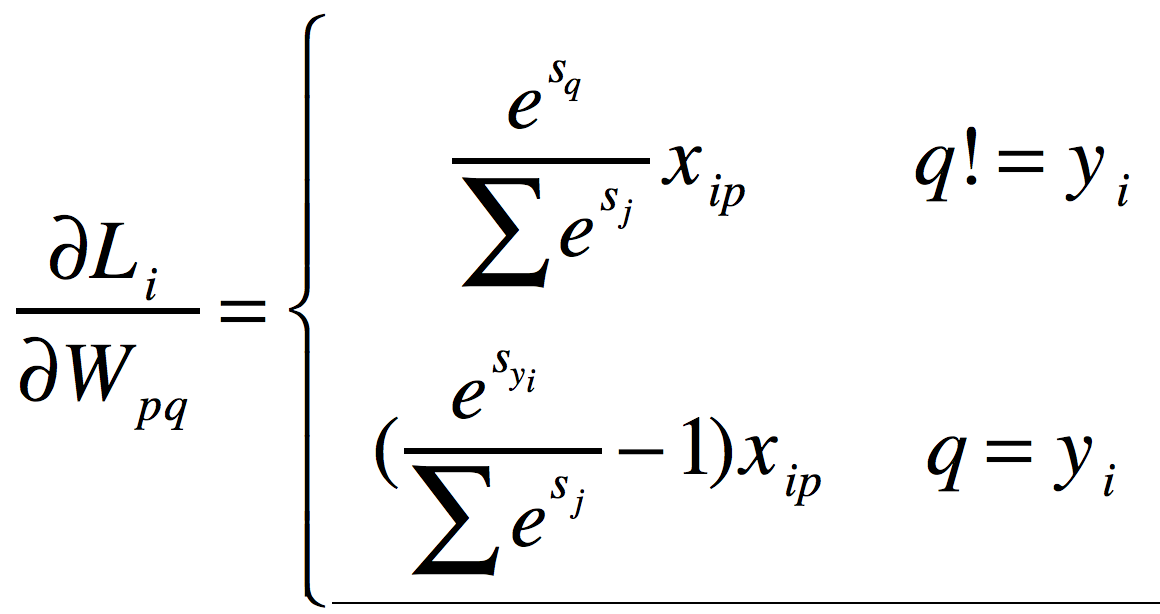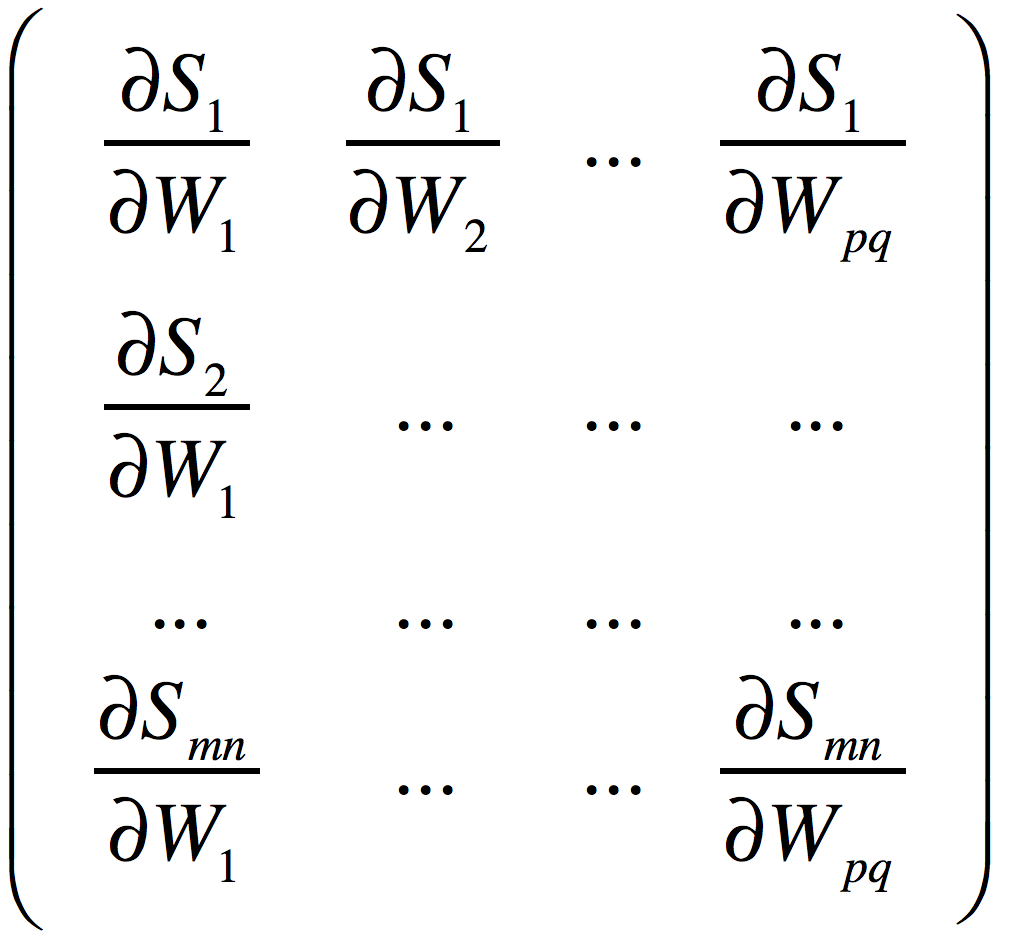一.作业要求
原版:http://cs231n.github.io/assignments2017/assignment1/
翻译:http://www.mooc.ai/course/268/learn?lessonid=1962#lesson/1962
二.作业收获及代码
完整代码地址:https://github.com/coldyan123/Assignment1
1 KNN
(1)有用的numpy API:
np.flatnonzero:返回展平数组的非零元素索引(结合布尔数组访问可筛选特定条件元素索引)
np.random.choice:随机采样常用(第一个参数可以是一维数组或整数)
np.argsort:返回排序后的索引值
np.argmax: 返回最大元素的索引值
np.array_split: 划分k折交叉验证集常用
np.vstack:纵向把列表中的数组拼起来(要求每个数组列数相同)
np.hstack:横向把列表中的数组拼起来(要求每个数组行数相同)
np.random.randn: 常用来初始化权重矩阵
(2)三种计算训练集与测试集L2距离矩阵的方式(two loop,one loop,no loop):
two loop(很暴力的方法):

def compute_distances_two_loops(self, X): """ Compute the distance between each test point in X and each training point in self.X_train using a nested loop over both the training data and the test data. Inputs: - X: A numpy array of shape (num_test, D) containing test data. Returns: - dists: A numpy array of shape (num_test, num_train) where dists[i, j] is the Euclidean distance between the ith test point and the jth training point. """ num_test = X.shape[0] num_train = self.X_train.shape[0] dists = np.zeros((num_test, num_train)) for i in xrange(num_test): for j in xrange(num_train): ##################################################################### # TODO: # # Compute the l2 distance between the ith test point and the jth # # training point, and store the result in dists[i, j]. You should # # not use a loop over dimension. # ##################################################################### dists[i, j] = np.sqrt(np.sum((X[i, :] - self.X_train[j, :]) ** 2)) ##################################################################### # END OF YOUR CODE # ##################################################################### return dists
one loop(用到了numpy数组的广播):

def compute_distances_one_loop(self, X): """ Compute the distance between each test point in X and each training point in self.X_train using a single loop over the test data. Input / Output: Same as compute_distances_two_loops """ num_test = X.shape[0] num_train = self.X_train.shape[0] dists = np.zeros((num_test, num_train)) for i in xrange(num_test): ####################################################################### # TODO: # # Compute the l2 distance between the ith test point and all training # # points, and store the result in dists[i, :]. # ####################################################################### dists[i] += np.sqrt(np.sum((X[i, :] - self.X_train) ** 2, axis=1)) ####################################################################### # END OF YOUR CODE # ####################################################################### return dists
no loop (将L2距离表达式展开,然后使用向量化方式巧妙实现):

def compute_distances_no_loops(self, X): """ Compute the distance between each test point in X and each training point in self.X_train using no explicit loops. Input / Output: Same as compute_distances_two_loops """ num_test = X.shape[0] num_train = self.X_train.shape[0] dists = np.zeros((num_test, num_train)) ######################################################################### # TODO: # # Compute the l2 distance between all test points and all training # # points without using any explicit loops, and store the result in # # dists. # # # # You should implement this function using only basic array operations; # # in particular you should not use functions from scipy. # # # # HINT: Try to formulate the l2 distance using matrix multiplication # # and two broadcast sums. # ######################################################################### dists += np.sum(X ** 2, axis=1).reshape((num_test, 1)) dists += np.sum(self.X_train ** 2, axis=1) dists += X.dot(self.X_train.T) * (-2) dists = np.sqrt(dists) ######################################################################### # END OF YOUR CODE # ######################################################################### return dists
(3) 完整代码
在这个练习中,我编写了knn的训练和测试步骤并理解基本的图像分类pipeline,交叉验证以及熟练编写高效的向量化代码。
https://nbviewer.jupyter.org/github/coldyan123/Assignments1/blob/master/knn.ipynb
2 多分类SVM
(1)多分类SVM损失函数及梯度:
样本i的损失函数:

(其中yi是样本i的真实标签,sj是该样本在类别j上的线性得分值,三角形是一个常数,表示保护值)
梯度(学会推导):

(2)两种实现SVM损失和解析梯度的方式
朴素法(两重循环):

def svm_loss_naive(W, X, y, reg): """ Structured SVM loss function, naive implementation (with loops). Inputs have dimension D, there are C classes, and we operate on minibatches of N examples. Inputs: - W: A numpy array of shape (D, C) containing weights. - X: A numpy array of shape (N, D) containing a minibatch of data. - y: A numpy array of shape (N,) containing training labels; y[i] = c means that X[i] has label c, where 0 <= c < C. - reg: (float) regularization strength Returns a tuple of: - loss as single float - gradient with respect to weights W; an array of same shape as W """ dW = np.zeros(W.shape) # initialize the gradient as zero # compute the loss and the gradient num_classes = W.shape[1] num_train = X.shape[0] loss = 0.0 for i in xrange(num_train): scores = X[i].dot(W) correct_class_score = scores[y[i]] for j in xrange(num_classes): if j == y[i]: continue margin = scores[j] - correct_class_score + 1 # note delta = 1 if margin > 0: dW[:, j] += X[i, :] dW[:, y[i]] += -X[i, :] loss += margin # Right now the loss is a sum over all training examples, but we want it # to be an average instead so we divide by num_train. loss /= num_train dW /= num_train # Add regularization to the loss. loss += reg * np.sum(W * W) dW += 2 * reg * W ############################################################################# # TODO: # # Compute the gradient of the loss function and store it dW. # # Rather that first computing the loss and then computing the derivative, # # it may be simpler to compute the derivative at the same time that the # # loss is being computed. As a result you may need to modify some of the # # code above to compute the gradient. # ############################################################################# return loss, dW
完全向量法:
很有技巧性,使用数组的广播来计算loss。由于观察到每次的梯度是训练集向量的线性叠加,使用计算loss中产生的中间矩阵lossMat来构造该线性权重矩阵H,该权重矩阵H大小为n*10,对于Hij,当样本i的正确分类不为j,如果max(si-syi+1)>0,则Hij为1,否则为0;当样本i的正确分类为j,则Hij为10个分类中max(si-syi+1)大于0的个数的倒数。其中max(si-syi+1)就是lossMat矩阵中的值。

def svm_loss_vectorized(W, X, y, reg): """ Structured SVM loss function, vectorized implementation. Inputs and outputs are the same as svm_loss_naive. """ loss = 0.0 dW = np.zeros(W.shape) # initialize the gradient as zero num_classes = W.shape[1] num_train = X.shape[0] ############################################################################# # TODO: # # Implement a vectorized version of the structured SVM loss, storing the # # result in loss. # ############################################################################# scores = X.dot(W) rightClassScores = scores[range(0, num_train), list(y)].reshape(num_train, 1) lossMat = scores - rightClassScores + 1 lossMat[lossMat < 0] = 0.0 loss = (np.sum(lossMat) - num_train) / num_train ############################################################################# # END OF YOUR CODE # ############################################################################# ############################################################################# # TODO: # # Implement a vectorized version of the gradient for the structured SVM # # loss, storing the result in dW. # # # # Hint: Instead of computing the gradient from scratch, it may be easier # # to reuse some of the intermediate values that you used to compute the # # loss. # ############################################################################# lossMat[lossMat > 0] = 1.0 lossMat[range(0, num_train), list(y)] = -np.sum(lossMat, axis=1) + 1 dW = X.T.dot(lossMat) / num_train + 2 * reg * W ############################################################################# # END OF YOUR CODE # ############################################################################# return loss, dW
实验表明完全向量化的代码比朴素法快十几倍。
(3)完整代码
- 实现了解析梯度完全向量化的表达式
- 使用数值梯度检查了解析梯度的正确性
- 使用验证集调参:学习速率和正则化强度
- 实现了优化损失函数的SGD算法
- 可视化最终学习权重,可以看出线性分类器相当于为每个类学出一个模版(对应权重矩阵的一行),进行模版匹配(可视化的方法是将权重进行归一化,然后乘以255)。
3 softmax



def softmax_loss_naive(W, X, y, reg): """ Softmax loss function, naive implementation (with loops) Inputs have dimension D, there are C classes, and we operate on minibatches of N examples. Inputs: - W: A numpy array of shape (D, C) containing weights. - X: A numpy array of shape (N, D) containing a minibatch of data. - y: A numpy array of shape (N,) containing training labels; y[i] = c means that X[i] has label c, where 0 <= c < C. - reg: (float) regularization strength Returns a tuple of: - loss as single float - gradient with respect to weights W; an array of same shape as W """ # Initialize the loss and gradient to zero. loss = 0.0 dW = np.zeros_like(W) ############################################################################# # TODO: Compute the softmax loss and its gradient using explicit loops. # # Store the loss in loss and the gradient in dW. If you are not careful # # here, it is easy to run into numeric instability. Don't forget the # # regularization! # ############################################################################# train_num = X.shape[0] dim = X.shape[1] class_num = W.shape[1] for i in range(0, train_num): scores = X[i].dot(W) Sum = 0 for j in range(0, class_num): Sum += math.exp(scores[j]) for j in range(0, class_num): if j == y[i]: dW[:, j] += (math.exp(scores[y[i]]) / Sum - 1) * X[i] else: dW[:, j] += math.exp(scores[j]) / Sum * X[i] loss += -math.log(math.exp(scores[y[i]]) / Sum) loss /= train_num dW /= train_num dW += 2 * reg * W ############################################################################# # END OF YOUR CODE # ############################################################################# return loss, dW
完全向量法:
这里与SVM的完全向量实现思路基本相同,都是构造出样本对于梯度的权重贡献矩阵H。搞懂了SVM的再来写这个简直易如反掌。

def softmax_loss_vectorized(W, X, y, reg): """ Softmax loss function, vectorized version. Inputs and outputs are the same as softmax_loss_naive. """ # Initialize the loss and gradient to zero. loss = 0.0 dW = np.zeros_like(W) ############################################################################# # TODO: Compute the softmax loss and its gradient using no explicit loops. # # Store the loss in loss and the gradient in dW. If you are not careful # # here, it is easy to run into numeric instability. Don't forget the # # regularization! # ############################################################################# train_num = X.shape[0] dim = X.shape[1] class_num = W.shape[1] scores = X.dot(W) exp_scores = np.exp(scores) tmp = exp_scores[range(0, train_num), y] / np.sum(exp_scores, axis=1) loss = np.sum(-np.log(tmp)) / train_num H = exp_scores / np.sum(exp_scores, axis=1).reshape((train_num, 1)) H[range(0, train_num), y] -= 1 dW = X.T.dot(H) / train_num + 2 * reg * W ############################################################################# # END OF YOUR CODE # ############################################################################# return loss, dW
(3)完整代码
- 实现了Softmax分类器完全向量化的损失函数
- 实现了解析梯度完全向量化的代码
- 用数值梯度检查了实现
- 使用验证集调整学习速度和正则化强度
- 使用SGD优化损失函数
- 可视化最终学习权重
https://nbviewer.jupyter.org/github/coldyan123/Assignments1/blob/master/softmax.ipynb
4 两层神经网络
(1)softMax loss和梯度的计算(完全向量法)
loss的计算非常简单:

# Compute the loss loss = None ############################################################################# # TODO: Finish the forward pass, and compute the loss. This should include # # both the data loss and L2 regularization for W1 and W2. Store the result # # in the variable loss, which should be a scalar. Use the Softmax # # classifier loss. # ############################################################################# exp_scores = np.exp(scores) loss = np.sum(-np.log(exp_scores[range(0, N), y] / np.sum(exp_scores, axis=1))) loss /= N loss += reg * (np.sum(W1 * W1) + np.sum(W2 * W2)) ############################################################################# # END OF YOUR CODE # ############################################################################
梯度的计算比较复杂,主要难在涉及到了矩阵对矩阵的导数(WX+B对W或X的导数),以及Relu层的导数。
a 矩阵线性变换的导数是一个常用的结论,需要记住(使用平铺矩阵jocabian法可以推出这个结论):
![]()
(等式右边是左乘右乘还是转置不用记忆,根据维度相容的方法可以现推出来)
b ReLu层的导数
Relu层表示为:
![]()
其中是对矩阵A进行逐元素地max(0,Aij)操作的,所以很容易得出:

其中,运算符![]() 表示逐元素想乘,函数
表示逐元素想乘,函数![]() 表示将矩阵H中的元素大于0的置为1,其余置为0。
表示将矩阵H中的元素大于0的置为1,其余置为0。
因此梯度的计算代码如下:

# Backward pass: compute gradients grads = {} ############################################################################# # TODO: Compute the backward pass, computing the derivatives of the weights # # and biases. Store the results in the grads dictionary. For example, # # grads['W1'] should store the gradient on W1, and be a matrix of same size # ############################################################################# #cal gradsOfLossByScore gradsOfLossByScore = exp_scores / np.sum(exp_scores, axis=1).reshape((N,1)) gradsOfLossByScore[range(0, N), y] -= 1 #cal grads['b2'] gradsOfLossByb2 = gradsOfLossByScore grads['b2'] = np.sum(gradsOfLossByb2, axis=0) / N # grads['W2'] = h.T.dot(gradsOfLossByScore) / N + 2 * reg * W2 # gradsOfLossByh = gradsOfLossByScore.dot(W2.T) gradsOfLossBya1 = gradsOfLossByh * (h > 0) gradsOfLossByb1 = gradsOfLossBya1 grads['b1'] = np.sum(gradsOfLossByb1, axis=0) / N grads['W1'] = X.T.dot(gradsOfLossBya1) / N + 2 * reg * W1 ############################################################################# # END OF YOUR CODE # #############################################################################
(2)完整代码
在这项练习中,我使用了高效的向量化代码实现了两层全连接神经网络的前向传播,反向传播,训练以及预测。并通过调节超参数,在验证集上达到了0.525的准确率,测试集上达到了0.519的准确率。
https://nbviewer.jupyter.org/github/coldyan123/Assignments1/blob/master/two_layer_net.ipynb
(3)关于反向传播的心得体会
在反向传播中,我们使用上游传过来的梯度乘以jocabian矩阵,得到特定参数的梯度,或者是使梯度往下传。但是注意,jocobian矩阵的定义是向量对向量的导数结果,如果遇到向量对矩阵,或者矩阵对矩阵的时候,我们应该用什么来乘以上游梯度呢?考察下面一个例子:
问题:已知上游传过来的梯度![]() (或称为G),并且有
(或称为G),并且有![]() ,要求梯度
,要求梯度![]() 。其中
。其中![]() 。
。
解法:在这个例子中,我们仍然使用雅可比矩阵进行传播,但是首先需要将S矩阵平展成一个(1,mn)的向量,将W矩阵平展成一个(1,pq)的向量,得到的雅可比矩阵是(mn,pq)大小的。然后我们将上游梯度![]() 平展成(1,mn)的向量,使用这个向量乘以雅可比矩阵,得到(1,pq)的向量,将这个向量恢复成(p,q)的形状,就是我们要求的梯度矩阵
平展成(1,mn)的向量,使用这个向量乘以雅可比矩阵,得到(1,pq)的向量,将这个向量恢复成(p,q)的形状,就是我们要求的梯度矩阵![]() 。
。
证明:现在证明上面解法的正确性。
记![]() 分别为三个矩阵平展开之后的第i个元素,那么,得到的(mn,pq)的雅可比矩阵如下:
分别为三个矩阵平展开之后的第i个元素,那么,得到的(mn,pq)的雅可比矩阵如下:

而G展开后为![]() 。将其乘以雅可比矩阵,得到向量:
。将其乘以雅可比矩阵,得到向量:![]() 。
。
这个向量中的第k个元素为:

很明显,将其恢复成(p,q)的形状就是要求的梯度矩阵![]() 。
。
5 图像特征实验
这一部分验证了提取一些图像特征能够达到更高的分类准确率。提取的特征有HOG和color histogram,用到已经实现的SVM和两层神经网络上。经过调参,神经网络在验证集上准确率超过了60%,测试集上达到了58.3%。
完整代码:
https://nbviewer.jupyter.org/github/coldyan123/Assignments1/blob/master/features.ipynb
